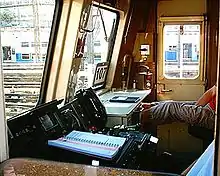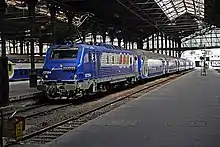Voiture de banlieue à 2 niveaux
The VB2N (voiture de banlieue à 2 niveaux, "two-deck suburban car") is a double-deck passenger car used on Transilien suburban rail services in the Île-de-France region of France.[2] The cars are unpowered and designed to be paired with an electric locomotive.
| VB2N | |
|---|---|
.jpg.webp) VB2N at Gare de Lavilletertre in 2011. | |
| Manufacturer | CIMT / ANF |
| Constructed | 1974 to 1984 |
| Number built | 589 |
| Operator(s) | SNCF |
| Specifications | |
| Car length | 24.28 m (79 ft 8 in)[1] |
| Width | 2.856 m (9 ft 4.4 in)[1] |
| Height | 4.32 m (14 ft 2 in)[1] |
| Maximum speed | 140 km/h (87 mph) |
| Track gauge | 1,435 mm (4 ft 8 1⁄2 in) standard gauge |
The coaches, built from 1974, are the successors of the Chemins de Fer de l'État's 1933 built Voiture État à 2 étages. They are currently in use on Line J and Line N of the Transilien network. They were previously used on RER lines C and D, Transilien lines H and K as well as services between Gare de l'Est and Gare de Tournan, which became the RER E.
Since 2012, the VB2N trains have been shifted from busier RER and Transilien lines to less busy routes on Transilien network as new equipment comes online, most notably the single-level Z 50000 "Francilian" and double-deck Regio 2N (Z 57000) trainsets. The VB2N trains are scheduled to be completely retired by the end of 2022.
Description

The VB2Ns are designed to be used in push-pull mode, although the cars are not powered, there is a control car at one end of the train so that the locomotive does not have to run around its train at the terminus.
Passenger space is divided in two levels. Each end of coach is a vestibule from which two separate sets of stairs lead to the upper and lower-decks. The walkway and seating on the lower deck is situated below platform level to gain space and avoid unnecessary height. The upper-deck is relatively spacious as height is restricted although adults may walk standing up.
All coaches have toilets apart from both end carriages.
Next stop is announced vocally and visually.
Speed is limited to 140 km/h (87 mph).
Use
Transilien Line J

On Transilien Line J, the VB2Ns are used on:
- Groupe IV (Gare Saint-Lazare-Gare de Mantes-la-Jolie via Gare de Conflans),
- Groupe V (Gare Saint-Lazare-Gare de Mantes-la-Jolie via Gare de Poissy),
- Groupe VI (Gare Saint-Lazare-Gare de Pontoise/Gare de Boissy-l'Aillerie/Gare de Gisors).
They are propelled by SNCF Class BB 17000 (numbered 17001 to 50, 56 à 58, 61, 64, 65, 78 to 80 and 17102 to 105).
The VB2Ns used on Transilien Line J have three numbering schemes, 90 upwards for coaches in original orange and grey livery, 101 upwards for coaches in IdF blue, white and red livery and 201 upwards for coaches in Transilien livery.
Transilien Line N
On Transilien Line N, the VB2Ns are used on:
On the Gare Montparnasse suburban network, VB2Ns are used on:
- Gare Montparnasse – Gare de Rambouillet
- Gare Montparnasse – Gare de Dreux
- Gare Montparnasse – Gare de Mantes-la-Jolie via Gare de Versailles-Chantiers
They were propelled by SNCF Class BB 25000 and BB 8500 before 2006, now by SNCF Class BB 27300, and SNCF Class BB 7600.
The VB2Ns used on Transilien Line N has a different number scheme. Their running number begins with a number representing the number of coaches the consist of VB2N possesses, followed by a letter, beginning with A.
Retirement
The VB2N equipment was retired starting in 2019, as Île-de-France Mobilités and SNCF replaced them with newer equipment. Since early 2019, the VB2N trains on the Transilien Line J are gradually being replaced by the Z 50000 "Francilian" single-level electric multiple unit (EMU) trainsets. Starting in 2021, the VB2N trains on the Transilien Line N are scheduled to be replaced by new Regio 2N (Z 57000) double-deck EMU trainsets.[3] Additionally, starting in 2022, some of the Transilien Line J traffic between Paris and Mantes-la-Jolie will be shifted to an extension of the RER E line which will be equipped with Z 58000 "RER NG" double-deck EMU trainsets.[4]
References
- "Suburban 2-level cars (VB2N) by Vitrains". gibitrains. Retrieved February 7, 2019.
- European Railways. 28–31. R.Spark. 1977. p. 146.
- "Des trains neufs pour les voyageurs des lignes N et D d'ici 2021". Île-de-France Mobilités (in French). May 24, 2017. Retrieved January 19, 2021.
- "Le futur RER d'Île-de-France se dévoile". Île-de-France Mobilités (in French). September 18, 2020. Retrieved January 19, 2021.
External links
 Media related to SNCF VB 2N coaches at Wikimedia Commons
Media related to SNCF VB 2N coaches at Wikimedia Commons